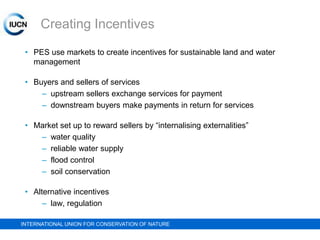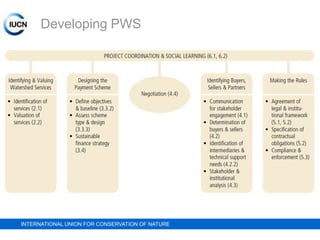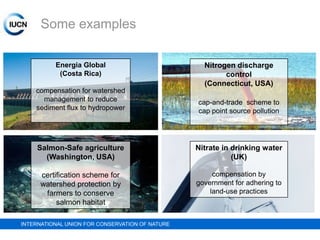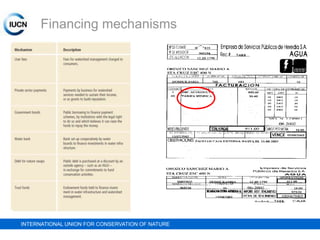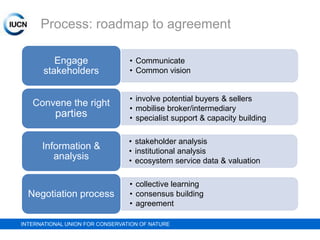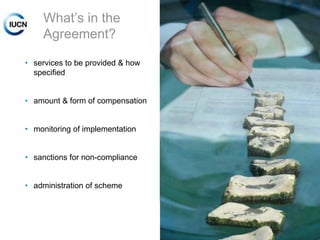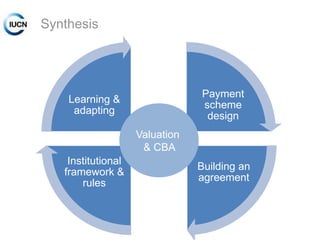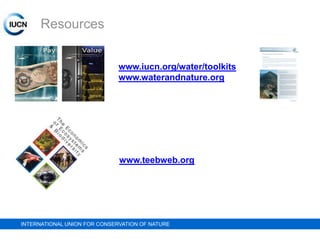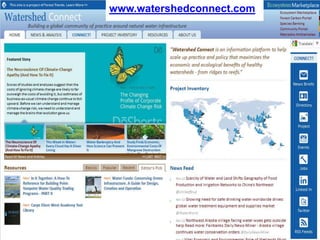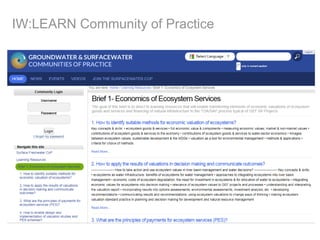Using Market-Based Instruments and Issues in Identifying, Designing and Implementing PES
- 1. Using Market-Based Instruments and Issues in Identifying, Designing and Implementing PES Dr Mark Smith IUCN Water Programme Gland, Switzerland
- 3. Using market-based instruments to protect water and wetland ecosystem services • Taxes, fees, subsidies and charges • Quantity-based instruments • Liability-based instruments • Voluntary schemes • Payments for Ecosystem Services (PES) INTERNATIONAL UNION FOR CONSERVATION OF NATURE
- 4. Scope and Limits of Market-Based Instruments • A complement to environmental regulation • Allow more flexibility for private actors, who can however choose between eg. polluting and paying • Often generate political opposition and generally less accepted than environmental standards • In some cases undermining other kinds of values e.g. ethics, culture, rights INTERNATIONAL UNION FOR CONSERVATION OF NATURE
- 5. 1. Incentives for water security 2. Valuing and managing watershed services 3. Designing a payment scheme 4. Roadmap towards an agreement 5. Rules at work 6. Learning from partner and experience INTERNATIONAL UNION FOR CONSERVATION OF NATURE
- 6. Creating Incentives • PES use markets to create incentives for sustainable land and water management • Buyers and sellers of services – upstream sellers exchange services for payment – downstream buyers make payments in return for services • Market set up to reward sellers by “internalising externalities” – water quality – reliable water supply – flood control – soil conservation • Alternative incentives – law, regulation INTERNATIONAL UNION FOR CONSERVATION OF NATURE
- 7. Requirements for a marketplace • recognition that watershed services can be traded • prices can be agreed • possible sellers exist – landowners, farmers, communities • possible buyers exist – utilities, hydropower, municipalities, governments, farmers, industry • brokers and facilitators • property, access and use rights established • transaction capacities: contracts and payment mechanisms INTERNATIONAL UNION FOR CONSERVATION OF NATURE
- 9. How are valuations relevant? • Valuations demonstrate benefits • Comparison of PWS to alternatives - CBA • Valuations ≠ price • Price depends on what it‟s worth paying INTERNATIONAL UNION FOR CONSERVATION OF NATURE
- 10. Basic logic of PWS
- 12. Developing PWS INTERNATIONAL UNION FOR CONSERVATION OF NATURE
- 13. Design – Payment for Watershed Services 1. Private payments 2. Cap and trade transfer payments land purchases cost-sharing regulatory cap tradeable permits PWS Schemes „salmon-safe‟ farms organic farming eco-labelling standards 3. Certification INTERNATIONAL UNION FOR CONSERVATION OF NATURE environmental taxes subsidies compensation schemes 4. Public payments
- 14. Some examples Energia Global (Costa Rica) Nitrogen discharge control (Connecticut, USA) compensation for watershed management to reduce sediment flux to hydropower cap-and-trade scheme to cap point source pollution Salmon-Safe agriculture (Washington, USA) Nitrate in drinking water (UK) certification scheme for watershed protection by farmers to conserve salmon habitat compensation by government for adhering to land-use practices INTERNATIONAL UNION FOR CONSERVATION OF NATURE
- 15. Financing mechanisms INTERNATIONAL UNION FOR CONSERVATION OF NATURE
- 16. Process: roadmap to agreement Engage stakeholders Convene the right parties Information & analysis Negotiation process • Communicate • Common vision • involve potential buyers & sellers • mobilise broker/intermediary • specialist support & capacity building • stakeholder analysis • institutional analysis • ecosystem service data & valuation • collective learning • consensus building • agreement INTERNATIONAL UNION FOR CONSERVATION OF NATURE
- 17. What‟s in the Agreement? • services to be provided & how specified • amount & form of compensation • monitoring of implementation • sanctions for non-compliance • administration of scheme INTERNATIONAL UNION FOR CONSERVATION OF NATURE
- 18. Making the rules Institutional Framework Clarify land & resource tenure Enforceable rules & transaction mechanisms INTERNATIONAL UNION FOR CONSERVATION OF NATURE Compliance & enforcement
- 19. Synthesis Payment scheme design Learning & adapting Valuation & CBA Institutional framework & rules INTERNATIONAL UNION FOR CONSERVATION OF NATURE Building an agreement
- 20. Resources www.iucn.org/water/toolkits www.waterandnature.org www.teebweb.org INTERNATIONAL UNION FOR CONSERVATION OF NATURE
- 21. www.watershedconnect.com INTERNATIONAL UNION FOR CONSERVATION OF NATURE
- 22. IW:LEARN Community of Practice
Editor's Notes
- #4: Taxes, fees and charges discourage environmentally harmful activities by increasing their costs compared to other more environmentally friendly alternatives. Subsidies, where duly targeted, reduce the costs related to sustainable activities or products, thereby increasing their marketcompetitiveness. In theory, environmental taxes are more efficient than regulation because they make agents with lower abatement costs pollute (and pay) less than those with higher costs.Quantity-based instruments, such as tradable permit schemes, set a limit on the use of a resource, allocate the use right certificates to the users by auctions or free of charge, and create an artificial market for trading the rights. Water banks are innovative instruments that are generally used to deal with droughts in order to use in urban areas part of the water normally employed in agriculture and to compensate the farmers for the economic loss that results.Liability-based instruments assign responsibility or preventing and remediating environmental impacts to those who cause them. An example is the liability regime established in the European Union, which specifically includes damage both to water objectives and biodiversity objectives within the scope of the regime. The law requires, for example, that if a company discharges pollutants causing damage which threatens the legalobjectives of EU water policy, it is required to pay for the restoration. This provides a strong incentive to avoid such damage.Voluntary offsetting schemes also exist that encourage private, companies and public bodies to offset their impacts by financing restoration or conservation projects. Currently, the most used offsetting schemes are voluntary carbon credits programmes, which in recent years have shown a promising growth rate. Carbon offsetting schemes represent an interesting option to find additional financing for wetland mangrove conservation or enhancement, because wetlands including mangroves provide an important carbon sequestration function.
- #5: The use of MBIs should be seen as a complement to environmental regulation, which is only adequate in some specific contexts. For example, water rights trading can only work where illegal water abstraction is prevented by effective regulation.MBIs typically allow more flexibility to private actors, who can choose between polluting and paying a tax or buy a tradable right or be subject to liability. Therefore, it may not be advisable to use them to protect high-value water and wetland ecosystems or to achieve site-specific protection goals.Incentive-based approaches are often designed using a trial-and-error procedure, which allows the tax or the amount of tradable permits to be gradually adjusted to reach the desired objective. For this reason, MBIs should not be used where failures can lead to severe and irreversibleenvironmental impacts.Introducing environmental taxes or charges often generates political opposition and is generally less accepted than setting technical requirements through environmental standards (hence a reward scheme tends to be more acceptable than a punitive charging or taxation scheme). Furthermore, MBIs can be questioned under an ethical point of view, as in some way they may be perceived as giving the “right to pollute” to those who can afford to pay.In some cases, monetary valuation and MBIs can even undermine the use of other kinds of languages and values (e.g. those related to ethics, culture, human rights), and evidence has been found on the fact that under some circumstances a monetary incentive can “crowd-out”moral, intrinsic motivations for environmental protection.
- #11: price depends on negotiation: buyers won’t pay more than an alternative (eg filtration plant); sellers won’t accept less than opportunity cost or cost incurred. Price depends on negotiation between them. If sellers costs are higher than willingness to pay or higher than cost of buyer’s alternative infrastructure, then there is no deal and PWS won’t work






